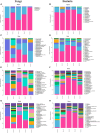Exploring the diversity, bioactivity of endophytes, and metabolome in Synsepalum dulcificum
- PMID: 38476934
- PMCID: PMC10929569
- DOI: 10.3389/fmicb.2024.1258208
Exploring the diversity, bioactivity of endophytes, and metabolome in Synsepalum dulcificum
Abstract
Synsepalum dulcificum exhibits high edible and medicinal value; however, there have been no reports on the exploration of its endophyte resources. Here, we conducted analyses encompassing plant metabolomics, microbial diversity, and the biological activities of endophytic metabolites in S. dulcificum. High-throughput sequencing identified 4,913 endophytic fungal amplicon sequence variants (ASVs) and 1,703 endophytic bacterial ASVs from the roots, stems, leaves, flowers, and fruits of S. dulcificum. Fungi were classified into 5 phyla, 24 classes, 75 orders, 170 families, and 313 genera, while bacteria belonged to 21 phyla, 47 classes, 93 orders, 145 families, and 232 genera. Furthermore, there were significant differences in the composition and content of metabolites in different tissues of S. dulcificum. Spearman's correlation analysis of the differential metabolites and endophytes revealed that the community composition of the endophytes correlated with plant-rich metabolites. The internal transcribed spacer sequences of 105 isolates were determined, and phylogenetic analyses revealed that these fungi were distributed into three phyla (Ascomycota, Basidiomycota, and Mucoromycota) and 20 genera. Moreover, 16S rDNA sequencing of 46 bacteria revealed they were distributed in 16 genera in three phyla: Actinobacteria, Proteobacteria, and Firmicutes. The antimicrobial activities (filter paper method) and antioxidant activity (DPPH and ABTS assays) of crude extracts obtained from 68 fungal and 20 bacterial strains cultured in different media were evaluated. Additionally, the α-glucosidase inhibitory activity of the fungal extracts was examined. The results showed that 88.6% of the strains exhibited antimicrobial activity, 55.7% exhibited antioxidant activity, and 85% of the fungi exhibited α-glucosidase inhibitory activity. The research suggested that the endophytes of S. dulcificum are highly diverse and have the potential to produce bioactive metabolites, providing abundant species resources for developing antibiotics, antioxidants and hypoglycemic drugs.
Keywords: Synsepalum dulcificum; biological activities; diversity; endophytes; metabolomics; microbiome.
Copyright © 2024 Liu, Hou, Zheng, Ma, Wen, Shao and Wu.
Conflict of interest statement
The authors declare that the research was conducted in the absence of any commercial or financial relationships that could be construed as a potential conflict of interest.
Figures









Similar articles
-
Plant tissue type and mineral contents shape endophytic bacterial communities in the Sisrè berry plant [Synsepalum dulcificum (Schumach & Thonn.) Daniell] in Benin.PLoS One. 2025 Jul 7;20(7):e0327715. doi: 10.1371/journal.pone.0327715. eCollection 2025. PLoS One. 2025. PMID: 40622965 Free PMC article.
-
Culturable Endophytes Diversity Isolated from Paeonia ostii and the Genetic Basis for Their Bioactivity.Pol J Microbiol. 2018;67(4):441-454. doi: 10.21307/pjm-2018-052. Pol J Microbiol. 2018. PMID: 30550230 Free PMC article.
-
Study of the Correlation Between Endophyte Abundances and Metabolite Levels in Different Parts of the Tissue of Cultivated and Wild Arnebia euchroma (Royle) Johnst. Based on Microbiome Analysis and Metabolomics.Molecules. 2025 Feb 6;30(3):734. doi: 10.3390/molecules30030734. Molecules. 2025. PMID: 39942836 Free PMC article.
-
Endophytic Fungi in Species of Artemisia.J Fungi (Basel). 2018 May 1;4(2):53. doi: 10.3390/jof4020053. J Fungi (Basel). 2018. PMID: 29724011 Free PMC article. Review.
-
Plant endophytes: unveiling hidden applications toward agro-environment sustainability.Folia Microbiol (Praha). 2024 Feb;69(1):181-206. doi: 10.1007/s12223-023-01092-6. Epub 2023 Sep 25. Folia Microbiol (Praha). 2024. PMID: 37747637 Review.
Cited by
-
The blueberry phyllosphere microbiota: tissue-specific core communities and their stability across cultivars and years.BMC Plant Biol. 2025 Jul 22;25(1):947. doi: 10.1186/s12870-025-06871-6. BMC Plant Biol. 2025. PMID: 40696300 Free PMC article.
-
Plant tissue type and mineral contents shape endophytic bacterial communities in the Sisrè berry plant [Synsepalum dulcificum (Schumach & Thonn.) Daniell] in Benin.PLoS One. 2025 Jul 7;20(7):e0327715. doi: 10.1371/journal.pone.0327715. eCollection 2025. PLoS One. 2025. PMID: 40622965 Free PMC article.
-
Diversity, antibacterial and antioxidant activities of fungi associated with Apis cerana.PeerJ. 2025 Aug 1;13:e19762. doi: 10.7717/peerj.19762. eCollection 2025. PeerJ. 2025. PMID: 40761805 Free PMC article.
References
-
- Bacon C. W. (2000). Microbial endophytes. 148. Boca Raton, FL: Chemical Rubber Company Press.
-
- Bernard M., Rousvoal S., Jacquemin B., Ballenghien M., Peters A. F., Leblanc C. (2017). qPCR-based relative quantification of the brown algal endophyte Laminarionema elsbetiae in Saccharina latissima: Variation and dynamics of host-endophyte interactions. J. Appl. Phycol. 30 2901–2911. 10.1007/s10811-017-1367-0 - DOI - PMC - PubMed
-
- Chao A., Chazdon R. L., Colwell R. K., Shen T. J. (2005). A new statistical approach for assessing similarity of species composition with incidence and abundance data. Ecol. lett. 8 148–159. 10.1111/j.1461-0248.2004.00707.x - DOI
-
- Chen D. B., Liu C. B., Jiang Y., Lyu Y. L., Jiang C. L. (2018). Diversity and bioactivity of un-cultured and cultivable actinomycetes from three toxic plants in Xishuangbanna, China. Microbiology 45 1100–1111. 10.13344/j.microbiol.china.170467 - DOI
LinkOut - more resources
Full Text Sources

